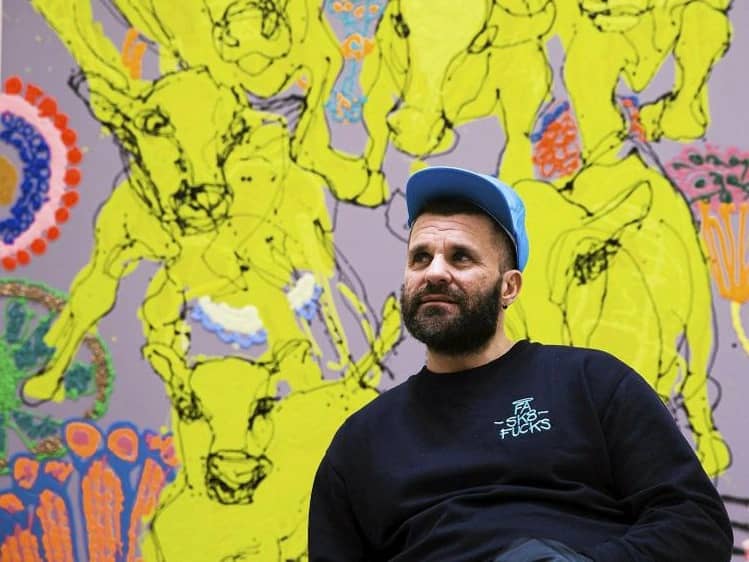Subscribe to wiki
Share wiki
Bookmark
Bjarne Melgaard
The Agent Tokenization Platform (ATP):Build autonomous agents with the Agent Development Kit (ADK)
Bjarne Melgaard
Bjarne Melgaard, born on September 9, 1967, is a contemporary Norwegian artist based in New York City. He is famous for his contemporary art works in sensory installations of putting pieces together to make a substance art, controversial furniture, expressionistic paintings and letter art[1]. Bjarne used to work on his novels since his childhood. He was hooked upon putting his thoughts and expressing himself in the form of novel. He says that novel is also a 'piece of art', surrounding us in the form of a book.
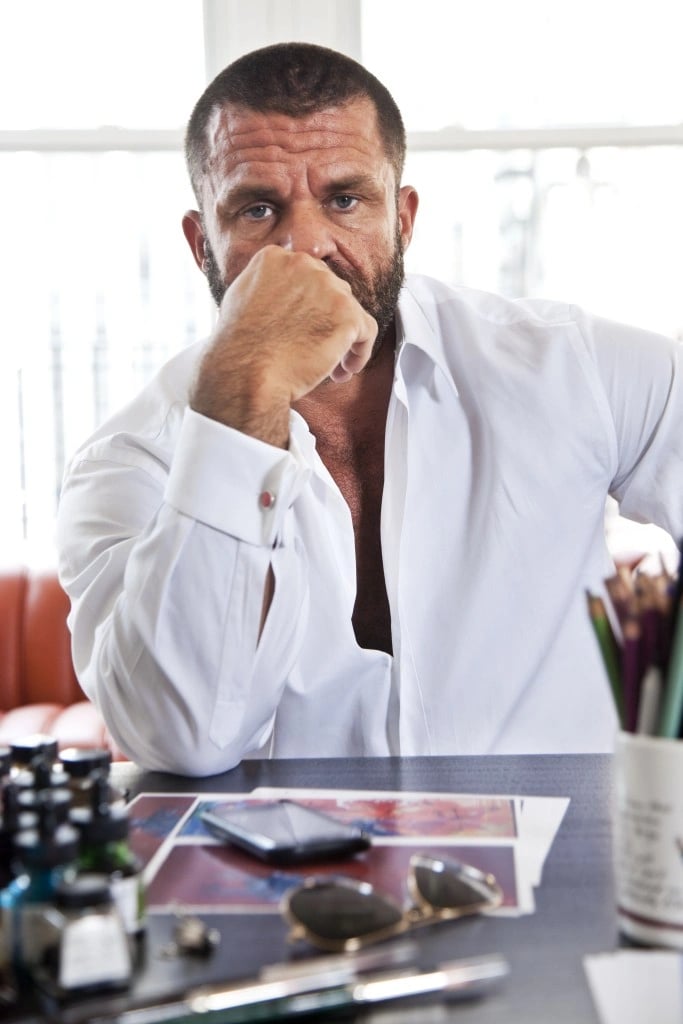
I was interested in fashion, and I was interested in writing. I published 14 novels—I’ve been writing since I was young. So it ties into everything I do. I also see my paintings as novels, my shows as novels. I guess that I see it as one. My writing has always been on my paintings and on my installations, so it’s always there and has been a part of it.
said Bjarne Melgaard in his interview at Red Bull Arts at New York.[14]
Early Life And Education
Bjarne Melgaard, 1967, was born in Sydney, Australia to Norwegian parents and was raised in Oslo, Norway. He graduated from National Academy of Fine Arts, Oslo, Norway in 1991. Later, he went on to study in Rijksacademie, Amsterdam, The Netherlands and graduated in 1992. In 1993, Bjarne completed his academics from Jan van Eyck Academie, Maarstricht, The Netherlands.[4]
Art Career
Social, political and ideological issues are at the core of Melgaard’s oeuvre. Bjarne Melgaard’s art deals with the dark side of humanity, such as self-destruction, deviant sexuality and odd religious beliefs. It discusses, investigates and pushes the boundaries of societal acceptance[3]. In addition to his visual art practice, Melgaard is a prolific curator, writer, film producer and fashion designer. His work has often explored provocative subcultures including heavy metal music, drug addiction, as well as augmented and virtual reality.
Bjarne's art works are often embedded with animals and humans made with thick oil paints, synthetic hair, makeup with mind itching colors having a monochromatic background.
Melgaard has exhibited extensively internationally, including solo exhibitions at Institute of Contemporary Arts (ICA), London (2012) and Astrup Fearnley Museum of Modern Art, Oslo (2010). He has also participated in the Venice (2011), Lyon (2013) and Whitney (2014) Biennials.
- In 1996, Museum van hedendaagse Kunst, Ghent, Belgium was his first solo art exhibition; Confessions of a Recovering Minimalist, Guillaume Bijl, Galleri c/o Alte Gerhardsen, Oslo, Norway.[5]
- His first ever fashion solo exhibition in New York in 2000, featured live chihuahuas in baby clothes and sculptures of apes engaged in explicit sexual acts. His most notorious works are also his most controversial.
- His exhibition, ‘Ignorant Transparencies’ at Gavin Brown’s enterprise, New York, in 2013, included a giant crack-smoking Pink Panther, covered in globs of psychedelic coloured paint, described as Melgaard’s alter ego.
I think the so-called subversive culture that is described in some of my works is a part of the common culture. It's just that it is not visible. Things that people surround themselves with on a daily basis in the media suddenly become much more provoking when they are treated in art
said Bjarne.[9]
- Melgaard particularly admires Aldrich's work saying,
Aldrich's work is so difficult to understand and that it’s not at all comprehensible. It’s also totally non-linear. It’s interesting to me what he does, because it’s so very far away from what I’m doing myself.
Indeed, Aldrich's vast white works seem to stand in complete visual contrast to Melgaard's vivid portraits, the subjects of which Meglaard keeps close to his chest. It is said that they're a mix 'of fictional and real people.'[12]
Controversies
Racist Chair
In January 2014, Bjarne's artwork Chair sparked controversy. Chair was sculpted in a provocatively sexual position and is a reinterpretation of a similar piece by British pop artist, Allen Jones. Offensiveness in art is often a way to satirise injustice. But this provocative sculpture has been naively injected into a popular culture which is to catch out celebrities and call them names as racist.[16]
The controversy began when Russian art socialite, Dasha Zhukova was photographed sitting on the cushion for a fashion website leading to raging online accusations of racism.
Zhukova, upon hearing this raging controversies, had replied as,
This photograph, which has been published completely out of context, is of an art work intended specifically as a commentary on gender and racial politics. I utterly abhor racism, and would like to apologise to anyone who has been offended by this image.
Melgaard himself released a statement responding to the controversy that was labelled by some writers as "bizarre".
Death House
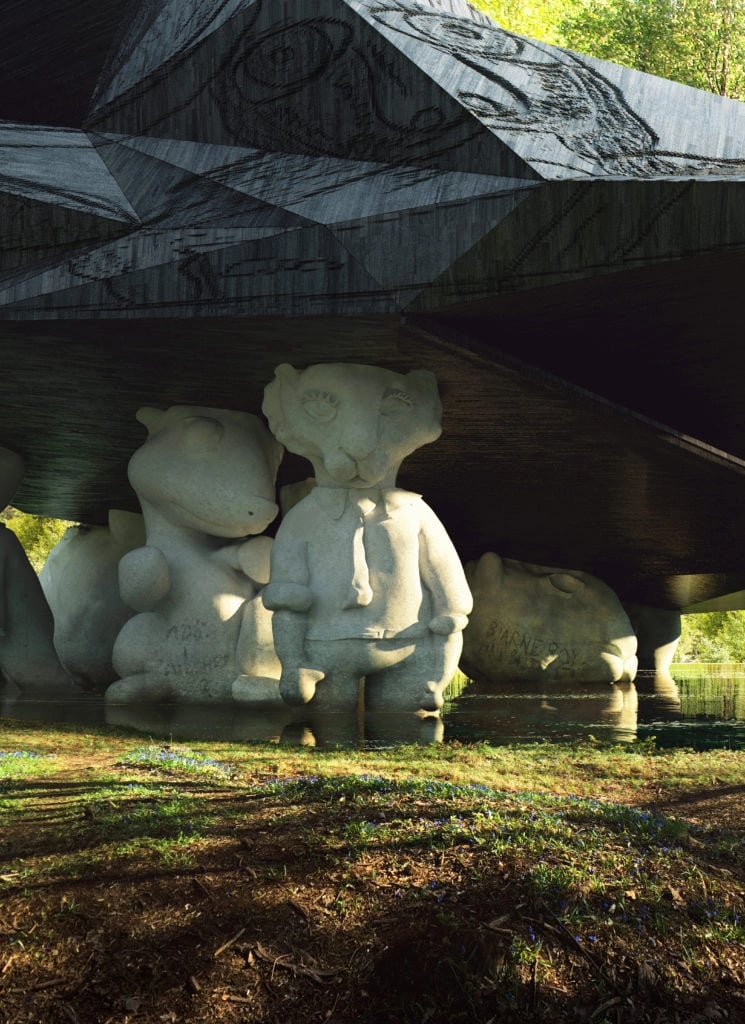
Melgaard’s planned building is shaped like a UFO. The building is clad with black, burned oak, inspired by Japanese building traditions. The burnt oak naturally erodes over time so that the building gradually changes character throughout the years and seasons. Bjarne’s drawings are projected back onto the geometrical facades.
Nothing has been built on the plot since the villa that used to adorn the plot was demolished in 1989, and the Selvaag brothers see a good opportunity to realize an ambitious art project on behalf of Bjarne Melgaard and to co-create a house that could function as his private residence and atelier.[11]
To build a spacey home beside the site of Edvard Munch’s former home has hit another setback in Oslo. On August 20, the city council blocked the project, referring to it a “death house” in their statement. Munch’s descendants claimed Melgaard was degrading Munch.
The Norwegian politicians opposed the construction of building by saying,
We want the site where the death house was intended to be placed to remain a green area for the benefit of the local population, and we encourage Bjarne to find a new site for the project.
Gym Queens Deserve To Die
In 2015, police were called to Bjarne’s exhibition at the Munch Museum in Oslo for allegedly sexualizing children, though the charges were dropped, where visitors complained about his video called Gym Queens Deserve to Die, which featured a model inserting a baby’s arm into his mouth in a sexualized manner. He was accused of pedophilia, but the Norwegian police found nothing criminal. The Munch museum strongly defended the exhibition and some pointed out that Munch himself was also a provocateur in his time.[15]
Visual AIDS
In 2012, in a performance piece called AIDS Roulette, six men are involved in sexual acts with one of them having positive for AIDS.
Elizabeth And Me
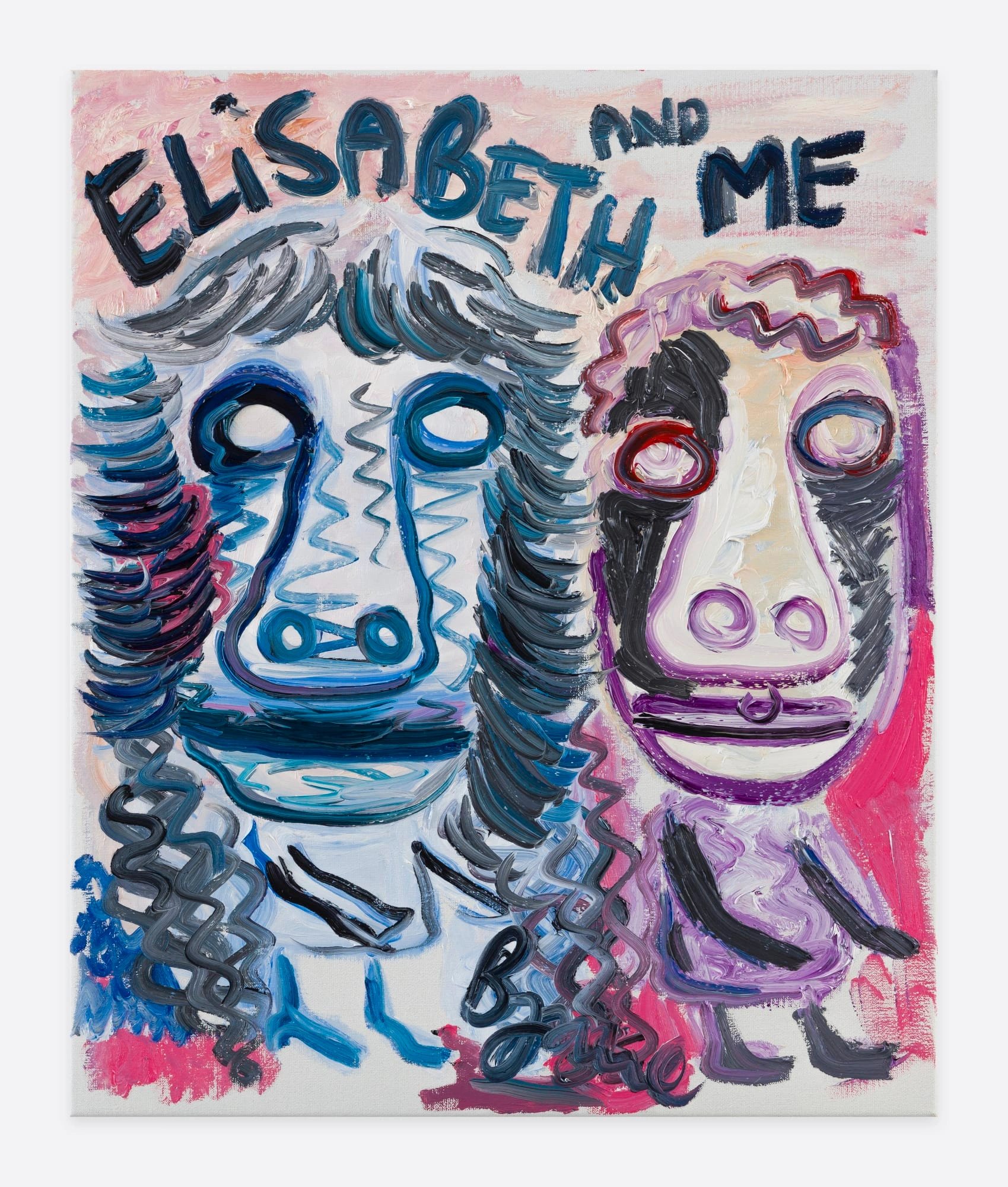
Bjarne has never met Elizabeth Wurtzel but felt close to her discomfort. He discovered that not only did they both have common roots in the Nordic culture, but they also had the same psychotherapist. Wurtzel’s provocative behaviour finds an echo in Bjarne's paintings, which presents her gestures as subversive and intuitive in bright colours with thick impasto that is condensed and left to dry.[13]
Casual Pleasure Of Disappointment
In 2017, Bjarne launched The Casual Pleasure of Disappointment, an unrelenting multi-site, multi-night, culmination of his ongoing 'fashion' project. He has transformed the two-story Red Bull gallery into what he deems a 'psychopathological department store,' replete with decaying fixtures reminiscent of suburban shopping center.

Exhibitions
From 1996 - 2021, Bjarne Melgaard has his art exhibited in over 220 solo exhibitions.
- Out of which, The Mutilation of the Apes, New York, Alleged Gallery, New York, USA, in 2000, has raised a rage between the people and made him a controversial artist, which involved
- In 2008, Faurschou, Copenhagen; Edvard Munch: Tribute And Inspiration has described Bjarne Melgaard as the most famous Norwegian artist since Edvard Munch, who was Bjarne's spiritual and stylistic mentor.
- In 2012, Institute of Contemporary Arts (ICA), London; Bjarne Melgaard: A house to die in, curated by Matt Williams, where his 'experimental lab' is in vision-to-be built on few figurines as a base also mentioned as, 'Death House'.
- In the same year, Visual AIDS at La MaMa Galleria, New York was curated, where, six men are involved in sexual acts with one of them having positive for AIDS.
- In 2015, Munch and Melgaard: The end of it all has already happened, Munch Museum, Oslo, Norway was famous for his tribute to Munch's death.
Public Collections And Literatures
Bjarne has over 16 public collections. In which, National Museum of Contemporary Art, Oslo has most of his publications.
- In 2002, 'Bjarne Melgaard - Interface To God' and 'Black Low // The Punk Movement Was Just Hippies With Short Hair' were published.
- In 2010, 'Bjarne Melgaard: Jealous' and 'Design: An Art Service' were published.
Lightbulb Man(LBM)
All his works have been published as ‘untitled’ by him. But, when Lightbulb Man piece is bought, it could be named and carved by imprinting into digital art history. 1025 unique works of art were published, the same, and yet entirely different. Melgaard created each piece with extraordinary and hidden traits that make every Lightbulb Man different to the next. Unique traits, colours, objects, and other markers - all conceptualised by Bjarne’s artistic expression.
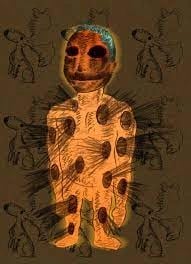
Bjarne Melgaard has partnered with serial entrepreneur Sam Farao to release a collection of 1122 unique Lightbulb Man NFT pieces, birthing new life into the infamous figure on the Ethereum blockchain. He had experimented with the Metaverse, creating the world of Skygge, the fictional realm that explores many of his work's darker themes.
The Lightbulb Man and his disturbing presence are not easily articulated beyond the figure itself, yet, reworking of the sculpture in sombre expressions against vivid colours with web3 distribution reopens discussion around the mythical piece. The physical Lightbulb Man is a lone bronze figure in the Norwegian National Gallery. [10]
AR & VR
Augmented Reality
For 2020, Bjarne Melgaard’s AR project uses characters and motifs from his wider oeuvre, which reference a multitude of current and historical affairs, from the colonisation of The Democratic Republic of the Congo in Central Africa to the international influence of Big Tech.[18]
Virtual Reality
His virtual reality artwork, My Trip (2019) takes the viewer/user on a journey to the farthest reaches of the dark web. He created immersive virtual landscapes, partaking in a virtual reality exhibition in Berlin where he utilised digital mediums to replicate the experience of the naturally occurring chemical DMT[Dimethyltryptamine], a naturally occurring drug, which is produced by a gland in the brain. DMT is considered the strongest hallucinogenic chemical substance and is found in almost every living organism on earth.
His work featuring characters that have recurred in the artist’s practice for over 25 years, including Lightbulb Man and Octo, in addition to new mutants and personalities created in collaboration with Acute Art, My Trip is a strikingly stimulating visualisation of the illusions of a DMT experience.
Beginning with the idea of suicide as an existential question, new psychedelia, and the loss of the self within a DMT trip, questions are asked regarding life and how people choose to live it whilst introducing Melgaard’s perspective on Anti-Natalism and over-population.[20]
In Nothing Special, displayed in 2002, at the Galleri Faurschou in Copenhagen, Bjarne transformed the gallery space into a total installation in which the presence/absence of the artist plays a key role, where the objects stacked together become alive. In this space, which seems a chaos of products consumed and expelled by an omnivorous and gigantic body, the spectator is completely absorbed. Among the artworks displayed, huge semi-transparent coloured banners, where we can see written the verse of a song “You are my sunken beach”. Together with the banners and the paintings in which emerge some characters that are recurring elements in Melgaard’s entire artistic story, there were a series of drawings, titled “Chemical Diary” and some small sculptures.[19]
Investors
- The Israeli-Russian billionaire Roman Abramovic purchased Bjarne's art in May 2013, during a Bukowski auction in Stockholm, Sweden.
- Jose Mugrabi and Vito Schnabel purchased Melgaard art during the same auction. Among other notable investors are Francois Pinault and Christen Sveaas. [6]
See something wrong?
The Agent Tokenization Platform (ATP):Build autonomous agents with the Agent Development Kit (ADK)
